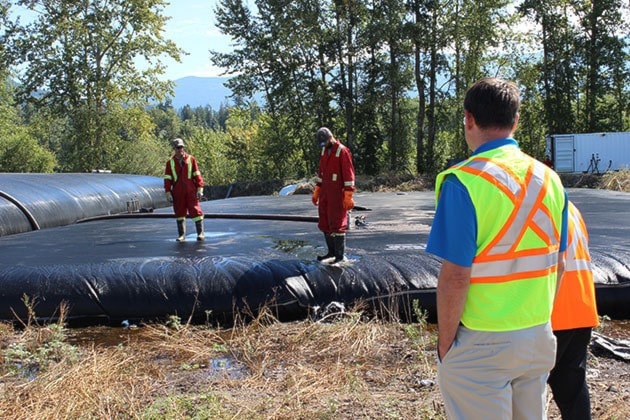Two huge pillow-like containment systems are currently being pumped full with, well, the stuff that arrives at the wastewater treatment plant from homes and businesses throughout Creston.
Called geotubes, the 100-foot-square envelopes are designed to be the final step in a sophisticated treatment process before dried waste is distributed on Town-owned farmland. When filled, the geotubes expand to nine feet high, but they are porous, allowing the liquid portion of sludge from the bulk volume fermenter (primarily effluent from Columbia Brewery) to slowly drain out, leaving dried, composting solids behind after a year or more of sitting untouched.
Lamborne Contracting, from Alberta, is currently on site at the Town’s facility west of Highway 21. Four personnel operating large pumping equipment and monitoring progress, have been working since last week to fill the geotubes.
“After a year or two the filled geotubes will compact down to about two feet thick, and then more sludge can be pumped into them at that point,” Town of Creston works superintendent Fred Schmidt said on Thursday. “When they are too full to keep reusing we slit them open and load the dried sludge onto trucks to haul away.” The dried product is trucked to Town land in Lister and the Creston Flats.
“This project is in partnership with Columbia Brewery and last year a centrifuge system was tried with many complications and a very high cost,” Mayor Ron Toyota said. “Columbia Brewery pays 90 per cent of the BVF operation and about 50 per cent of WWTP operations.
“Monitoring the success of this project could result in a more permanent solution, that being our own equipment versus contracting out and, perhaps, even providing our services to other small municipalities.”
As he led a small group on a tour of wastewater treatment facilities, Schmidt pointed out the areas where waste from septic pumping trucks is unloaded. Growing among the healthy crop of weeds was a scattering of tomato plants, with fruit developing nicely.
“Often seeds that end up in septic tanks sprout, and this is the result,” he smiled. “This is a nitrogen-rich environment.”
